3p’s Plant-Based Back-to-School Guide


Some kids are already back at school this week; next week is the big week for most students; the few lucky ones will have till after Labor Day. Whether we’re out of, or still in school, this year will feel much different when than a year ago, when we were teased to a summer largely free of lockdowns till things went awry with the virus again. While the pandemic and the Delta variant aftermath has become an era most of us at the very least just want to forget about – there is one industry that has benefited: the plant-based foods sector. We’ve been covering the industry here on TriplePundit for a reason – the market is hot, and the foods keep improving.
And who’s to blame consumers for shifting more toward plant-based protein options, as beyond the shortages, there were the COVID outbreaks, more product recalls – and face it, as we’ve reached “code red” with climate change, promises of supply chain innovations and promises of respecting animal welfare simply are not resonating with more people?
To that end, if you’re buying into the plant-based lifestyle, here are a few ideas from 3p that can help kickstart your day.
Breakfast bowls, sans the pork bacon
We’ve long said good-bye to that carb-heavy breakfast of cereal, toast with spread and orange juice. It was supposed to be a “square meal,” but too many of us ended up pear-shaped instead. Anyway, breakfast keeps being reinvented, and it’s becoming even more protein-based.
On that point, you might know Sweet Earth for its seitan strips, fake chicken (try the chipotle!) cauliflower mac, plant-based burgers, and hot dog alternatives that pan-fry well for any meal. Now you can add breakfast bowls to that lineup. The three flavors vary in levels of spiciness; all are packed with protein and have a decent amount of fiber. Fire them in the oven for 40 minutes if you have the luxury of time; two minutes in the microwave if you’re in a rush.
For lunch at the virtual office or in the company break room, Sweet Earth also has a wide range of deli “meats” and bowls as well.
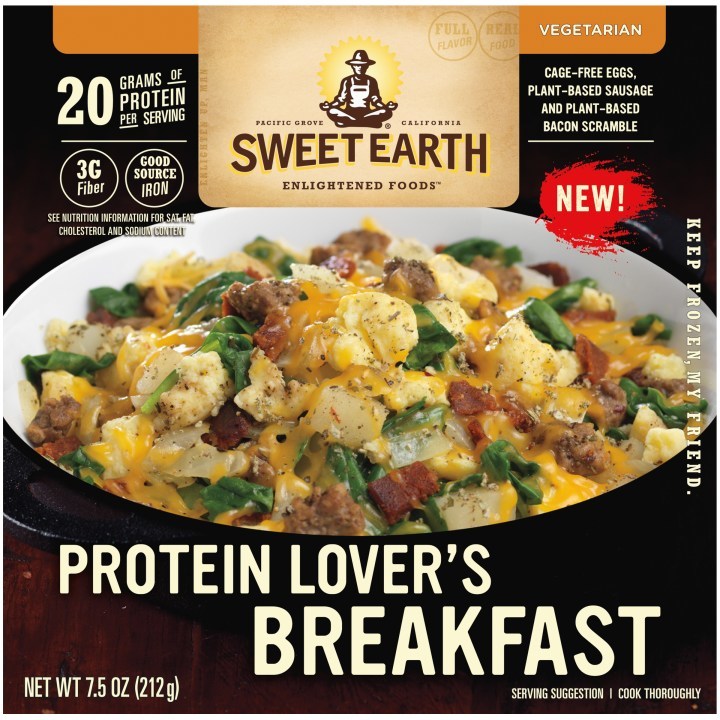
Breakfast cereal 2.0
Breakfast cereal has sure evolved since corn flakes were invented by a pair of brothers running a Michigan sanitarium. In this century, years of stagnant sales quickly turned into a boom time last year as far more people found themselves working from home during the pandemic or did our best to add to our COVID bodies. While we all have our favorites, either for our morning start, as a snack - or in the case of Jane Fonda’s character on Grace and Frankie, maybe we’re hiding stacks of Benjis in those boxes (Season 7, Episode 1).
Nevertheless, cereal is always ripe for a reinvention. Catalina Crunch has turned the idea of sugary, carb-laden breakfasts on its head. The pea protein-based cereals sure taste like the breakfasts of our youth, whether you sample the cocoa or peanut butter flavors. Mind you, these cereals cost far more than the ones you’re accustomed to seeing in the supermarket aisle. If you have a Costco membership, the company’s Cinnamon Toast crunch, packed with 9 grams of fiber, 11 grams of protein and no sugar, is a better value and may be available at your local warehouse store.
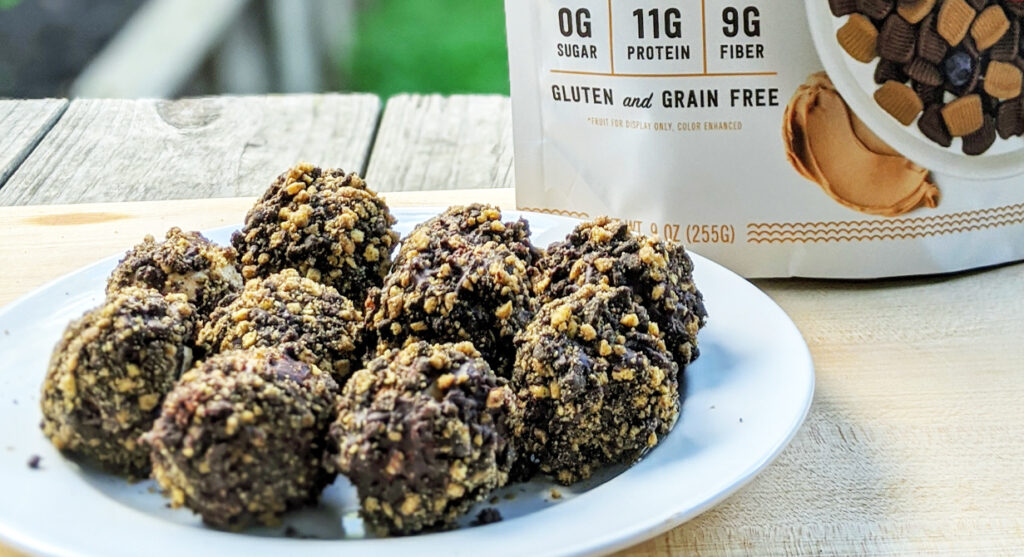
Just fake, plant-based eggs
Yes, Moira Rose - you just fold it in!
Just’s egg alternatives have been around a while, but 3p still gives them a shout-out as they rank among the best in the plant-based breakfast space. The company’s folded egg, which come four per carton, are a winner. While they’re best pan-fried in olive oil, if you’re in a hurry, they are more than passable microwaved. Just recommends these mung bean-based goodies be cooked in the toaster. The company’s sous vide bites are worth a try, too.
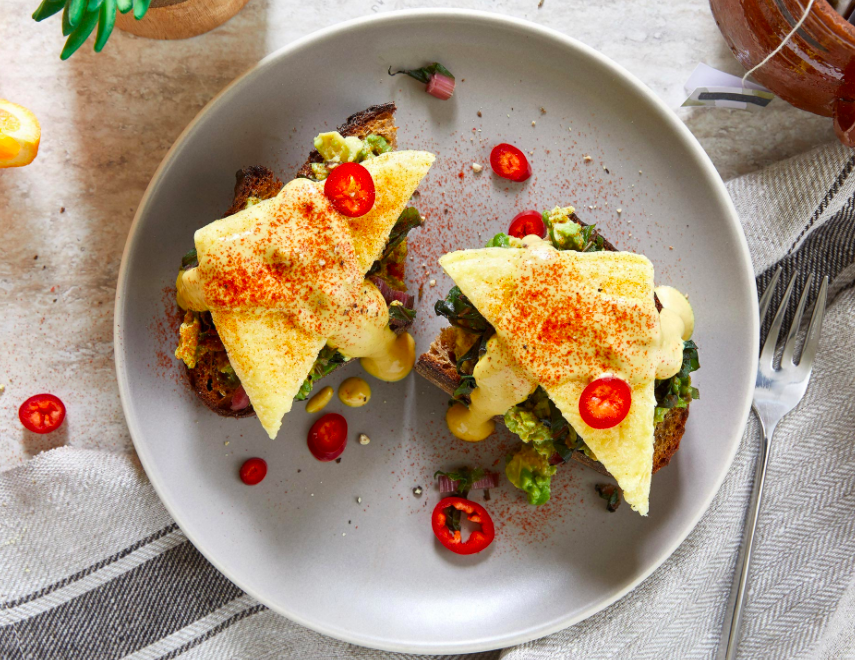
Pistachio milk
If you want a real treat and savor the taste of pistachio-flavored anything, then try Three Trees’ pistachio-based milk. It’s not anywhere as watery as most almond milks, doesn’t have the funk of hemp, flax or similar plant-based beverages, and honestly, the scent will remind you of a bakery in Istanbul, Tehran, or Glendale, CA… or the west side of LA. Mind you, considering the price per bottle, this is a splurge. Gently warm a cup or so on the stove top, add a few cardamom pods and you’ve got a new breakfast beverage – or it could be one half of that a.m. café au lait.
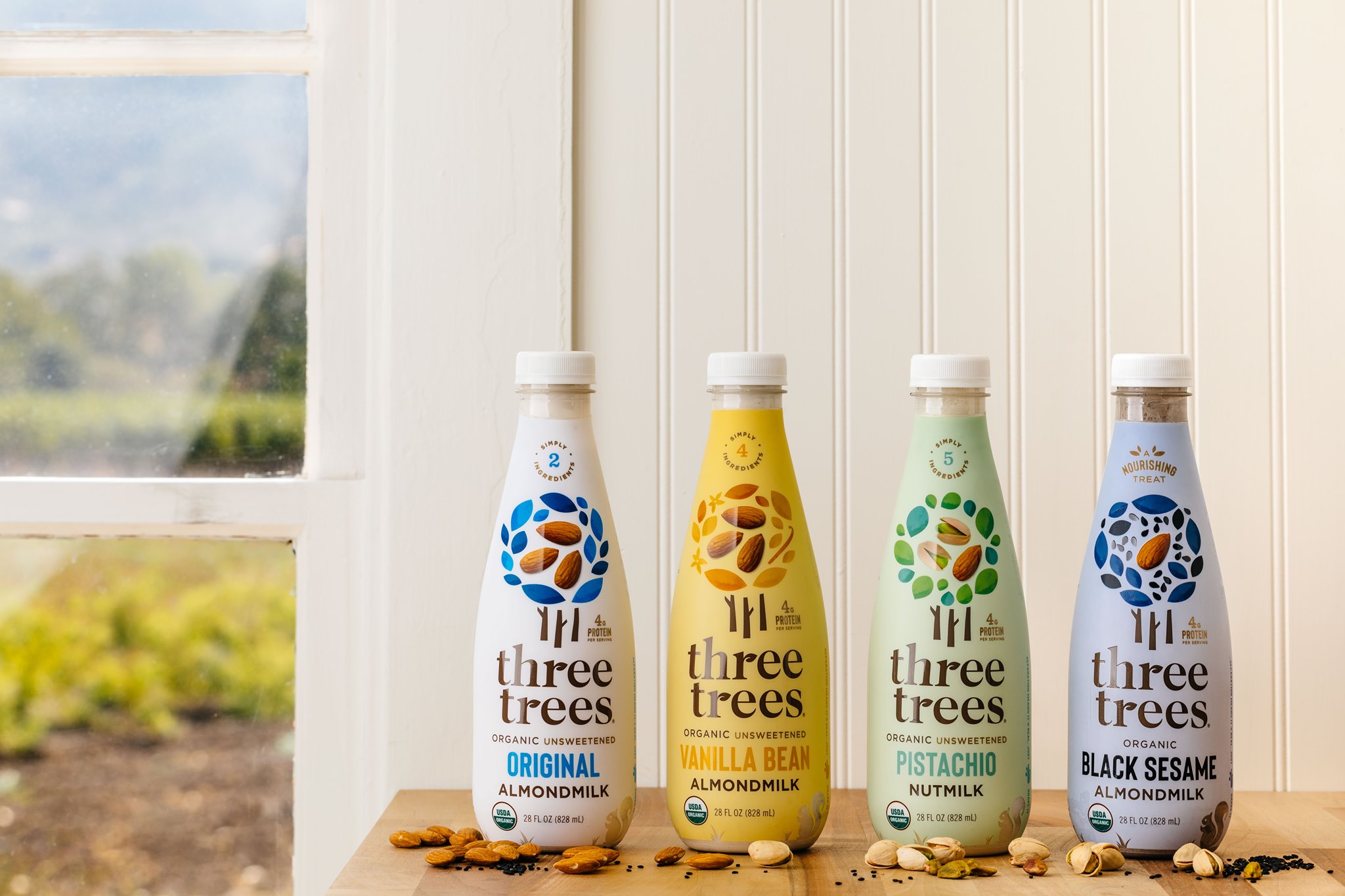
A backpack derived from trees
Plant-based doesn’t have to apply solely to morning grub. If you or one of your charges is in need of a backpack and doesn’t want a standard polyester one - and to be clear, if you have a budget that allows for spending beyond Target - check out Fjällräven’s Tree-Kånken backpack. These 16-liter packs are sturdy, eschew chemicals and according to the company, more than 90 percent of the water used to manufacture them is recycled.
The secret? The material used in these backpacks are made from a yarn derived from spruce and pine trees in Sweden. Yes, it’s true that Nordic country has had its own problems with deforestation. Nevertheless, Fjällräven says the fibers needed to make the Tree-Kånken comes from FSC-certified forests.
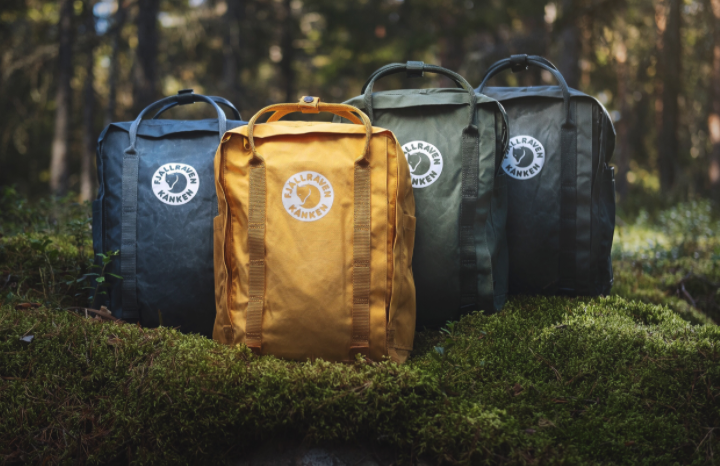
Your dog will soon score less attention. So, be Shameless!
Generally, dogs have been happier than people during the pandemic – after all, more were adopted during that time (Sadly, human beings are often awful, and shelters are getting crowded again.). And, our furry friends enjoyed far more company with many of us working and studying from home. As we spend more time away at the office, school or with friends, dog parents will have to compensate for that time spent alone.
Consider Shameless Pets dog treats as an option. These canine snacks are made with upcycled ingredients – for example, one flavor is made with blueberries that otherwise would have been discarded after picked. And while we’ll leave the benefits of a canine vegan diet to the veterinarians, one benefit of these meat-free treats is that the ingredients don’t come from some dubious overseas origin.
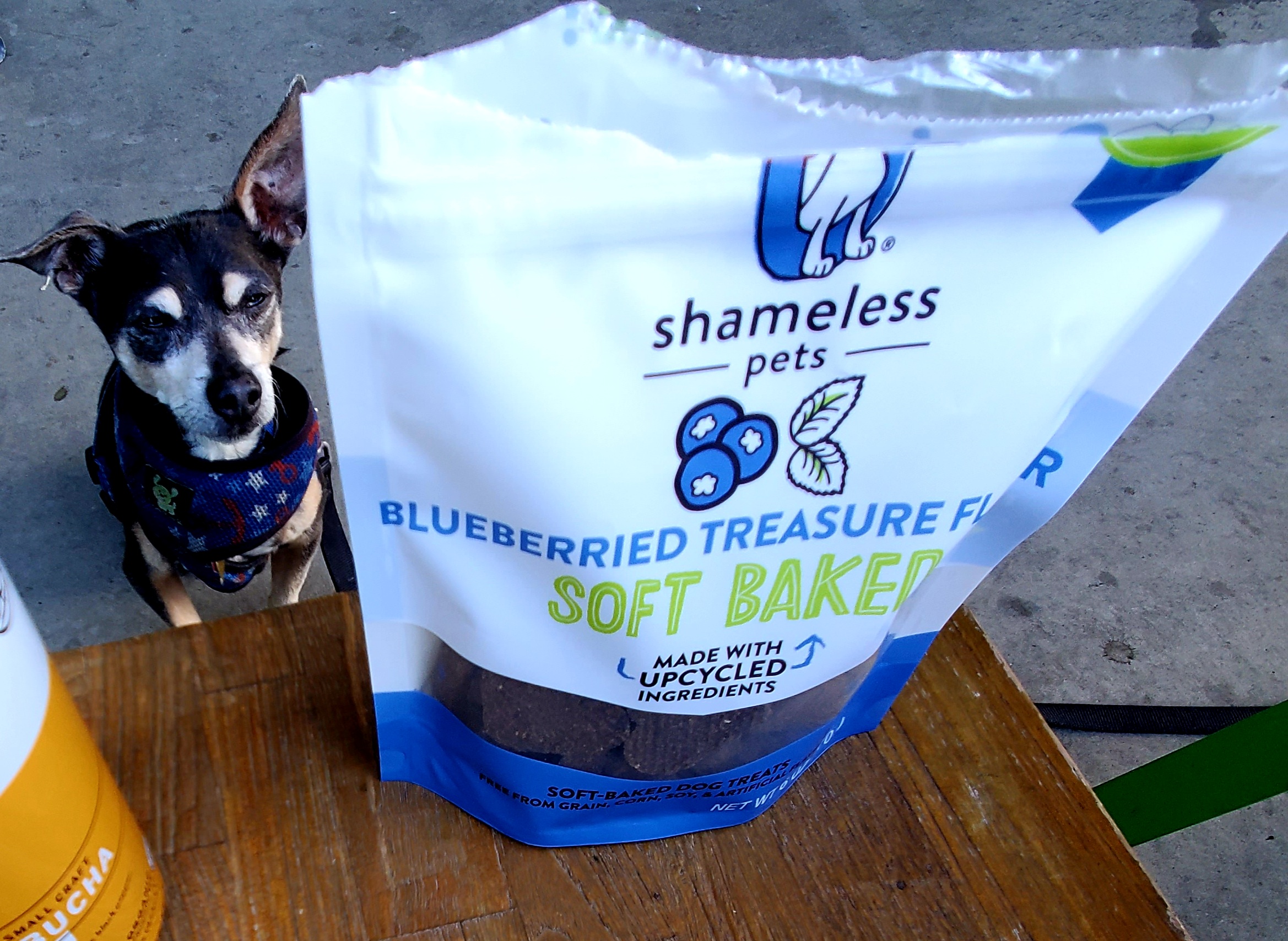
Image credit: Catalina Crunch
Companies Step Up to Support U.S. Students Returning to School


It could take years to fully understand the impact of the COVID-19 pandemic on U.S. students and schools. But educators and experts already know that as schools reopen, families and educators are still in the throes of financial uncertainty and academic struggles, and the needs are extensive.
“The past year has been so challenging for K-12 students,” said Ann Pifer, executive director of the nonprofit AdoptAClassroom.org. “We thought we were making progress, but the lack of vaccines [for children younger than 12] will mean masks and distancing again for many school districts. The biggest issue is learning loss and helping students catch up. And going into this year, the needs are bigger than ever.”
AdoptAClassroom.org has provided funding for school supplies to classrooms and families in need since 1998. The nonprofit pivoted to offer immediate assistance to ease distance learning in the early months of the pandemic, and now it’s challenged to do so again as schools welcome back some students who have not been in physical classrooms in over a year. With school doors already opening in many districts, 92 percent of classrooms have students whose families cannot afford to purchase any school supplies for their children.
The early months of the pandemic illuminate inequities in education
As the pandemic shut down schools, educators were sent scrambling to create new lesson plans and become instant experts in distance learning. The situation not only brought national attention to many of the inequities among school districts, but it also exacerbated them. “There are vast differences between schools and between districts, and the public has not been aware of the extent of that issue,” Pifer told 3p. “The pandemic emphasized the technology gap: It showed where some students don’t have technology at home,” she added. “Before it was an inconvenience. Now we know it is a major equity issue.”
Launched in March 2020, AdoptAClasroom.org’s COVID-19 Relief Fund for Teachers and Students aimed to deploy rapid funds to purchase tablets and other supplies to help students reconnect with their teachers at high-needs schools across the nation, including New York, Boston, Chicago and Los Angeles. In general, about 80 percent of the classrooms funded by the organization last year were located in high-needs schools nationwide
But despite this effort and many others like it across the country, the inability to access classroom materials, including laptops, caused many students to fall behind. According to 65 percent of teachers surveyed by AdoptAClassroom.org, students who did not have the necessary tools were less likely to participate during distance learning. More than half of teachers said they had students who did not engage with their curriculum during the last school year at all.
Teachers have been pulling out their own checkbooks to make up the funding gap. According to AdoptAClassroom.org, about 96 percent of teachers purchase supplies for their students, spending an average of $750 annually. Increased student needs during remote learning prompted teachers to dig deeper: About 30 percent of teachers surveyed by AdoptAClassroom.org reported spending $1,000 out of pocket on supplies last year. “A lot feel like they have to pull their own money,” Pifer said. “I wish more members of the public knew the sacrifices teachers make. Teachers were under incredible stress.”
As students return to school, businesses and community groups step up to resource classrooms
Studies show that while most children lost some academic ground over the past 18 months, students of color are falling further behind than their white counterparts. Those students and others who were under-resourced during distance learning will be playing catch-up this year, and the need is too great for even generous educators to meet on their own. “Classroom budgets will not be enough to cover expenses this year,” Pifer told us.
Businesses and community organizations are stepping up to meet the need, many in partnership with AdoptAClassroom.org: Educators can register on AdoptAClassroom’s website and list the supplies or services they need, and AdoptAClassroom finds sponsors for them. The group has 30 partners participating at varying levels, some supporting classrooms throughout the year and others holding fundraisers for specific events. “Consumers care more than ever before what companies are doing to support communities, and whether they see them as positive forces,” Pifer said.
One company supporting these efforts is Subaru of America, which has worked with AdoptAClassroom.org since 2016 as part of its Subaru Loves Learning initiative and this year expanded its participation. More than 600 Subaru retailers are partnering with high-need schools in their local communities, helping to ensure better education outcomes for K-12 students. AdoptaClassroom.org matches Subaru retailers with Title 1 schools in their local community and retailers work with school Principals to select classrooms that are in need to “adopt”. Teachers of the adopted classrooms are given funding that they can use directly on AdoptaClassroom.org’s marketplace, where teachers can purchase items for their students or their classroom. Through the Subaru Loves Learning campaign, Subaru will help more than 114,000 students and more than 4,700 classrooms across the country.
"At Subaru, we are committed to ensuring that students have the resources they need to not only learn, but to bring the subjects to life, fostering real interest and intellectual growth in each young individual," Alan Bethke, senior vice president of marketing for Subaru of America, Inc., said in a statement. "We're excited to work with AdoptAClassroom.org to make learning more accessible for all children and get them on the path to success."
Pifer is impressed with the automaker’s vision. “I love the way Subaru really sees the big picture,” she said. “They know it’s about helping students succeed in schools. But they are not just giving money; it’s a broad and holistic approach.”
Corporations also are responding to a broader scope of needs. “We’ve really seen significant shifts in corporate philanthropy over the past year,” Pifer observed. “We see it being more responsive to societal issues, such as racial equity. It has caused many corporations to think about what they can do to make a difference.”
For example, AdoptAClassroom.org launched the Racial Equity in Schools Fund last June in response to demand from educators for more and better learning tools for students who are Black, Indigenous and people of color (BIPOC). “We received an unprecedented number of grant applications, more than ever before,” Pifer recalled. Donors overwhelmingly responded to the requests, and 574 educators across the country received funding to improve education for students of color. “Teachers needed materials and training to make changes in classrooms,” Pifer said.
Stories like these are bright spots amidst the harsh lessons of the COVID-19 pandemic. Society has learned where many of the educational inequities are, and now the assignment is to address them so schools are not caught off guard again. “We have to put more focus on how we can bridge that technology gap and think about planning for the future,” Pifer said. “Schools need to be better prepared for future crises.”
This article series is sponsored by Subaru and produced by the TriplePundit editorial team.
Image credit: wavebreak3/Adobe Stock
Suddenly, Everything Just Got a Whole Lot Easier for Vaccine Mandates


Now that the Pfizer-BioNTech COVID-19 vaccine has received final approval from the Food and Drug Administration (FDA), employers should have a smooth pathway towards imposing vaccine mandates that protect their workers and their business from a lethal virus. Nevertheless, it will take a combination of patience and courage to overcome the collective hysteria that has engulfed tens of millions of Americans in COVID-19 vaccine refusal.
The FDA would like to have some words with you
The FDA’s announcement on the Pfizer approval has provided employers with ample support for imposing vaccine mandates.
The Pfizer vaccine, marketed under the name “Comirnaty (koe-mir’-na-tee), has received final approved for ages 16 and up, which covers the bulk of the workforce. Ages 12 to 15 can continue to receive Comirnaty under its emergency use authorization. That covers practically every child or teenager who does odd jobs for the neighbors, helps in the family business, or holds a youth work permit.
In a press release, the FDA took a dig, though a mild one, at vaccine refusers who claim that the vaccine is untested. “While millions of people have already safely received COVID-19 vaccines, we recognize that for some, the FDA approval of a vaccine may now instill additional confidence to get vaccinated,” explained Acting FDA Commissioner Janet Woodcock, M.D. (emphasis added).
The “untested” argument may have washed when the Pfizer vaccine was first made available last December, though the accusation is a slap in the face to the thousands of volunteers who participated in tests leading up to the authorization. Millions more have received it on an emergency basis. If that’s not sufficient testing, what is? Nevertheless, the FDA anticipates that final approval will make the difference for many vaccine refusers.
Vaccine safety: who can you trust nowadays?
The FDA’s optimism may well be justified. However, it is all but certain that millions of refusers will remain unswayed.
In the announcement of the approval, the FDA described its rigorous approval process in excruciating detail. Unfortunately, many of the very people who should read the FDA’s press release will not even know it exists.
If anything, vaccine refusers will probably zero in on the fact that FDA Commissioner Janet Woodcock holds her position in an acting capacity and is therefore not the “real” head of the agency.
That argument would ignore Dr. Woodcock’s professional credentials and long history with the FDA, which dates back to 1986. She assumed the “Acting” title in January, after Trump’s appointee, Stephen Hahn, stepped down.
Continuity in leadership should have been a priority during the COVID outbreak, except that during Hahn had no previous experience of any substance in food or drug analysis. He was clearly unfit to establish public trust in the FDA’s vaccine approval process. During his brief tenure, he compiled a reputation for promoting unproven treatments including hydroxychloroquine.
Unfortunately, Woodcock also brings some baggage to the trust table. She is reportedly not in the running for the permanent Commissioner title when her term expires in November, possibly due to controversy over her recent decision to approve a treatment for Alzheimer’s against the conclusions of an advisory panel.
The roots of vaccine mistrust
The next permanent FDA Commissioner will have their work cut out for them, no matter how many COVID-19 vaccines receive final approval.
The main challenge will be stemming the tide of inaccurate information and outright lies that receive widespread attention through today’s media.
Even before the COVID-19 outbreak, medical professionals had become alarmed over the power of self-professed experts — including those with medical degrees — to sway millions through television appearances and other media.
Some observers also believe that a tipping point on the influence of quackery occurred long before the advent of the internet and social media. In 1998, the prestigious journal The Lancet published an article by the former physician Andrew Wakefield connecting the common measles-mumps-rubella vaccine to autism. The article was later revealed as fraudulent and The Lancet withdrew it in 2010, but the damage was done.
A new public opinion study currently under consideration for publication by the research organization Plos One indicates that the 1998 Wakefield article was indeed highly influential. Though refusal of the MMR vaccine was and continues to be rare in the U.S., the researchers found evidence that the article sparked significant negative attitudes toward the MMR vaccine among the public.
The case for vaccine mandates vs. the rule of public opinion
The new study, titled “Quantifying The Effect of Wakefield et al. (1998) on Skepticism about MMR Vaccine Safety in the U.S.,” cites television and radio as the pre-Internet influencers that amplified falsehoods in the Wakefield article, exposing millions to fraud well beyond the rarified audience of The Lancet itself.
Multiply that by millions more, and you have the age of social media and the Facebook effect. In particular, critics of Facebook say the company continues to shoulder much of the blame for circulating misinformation and damaging lies about vaccine safety, despite taking some steps to clean up the discourse.
On the bright side, the new study on the Wakefield fraud indicates that vaccine mandates can far outweigh popular opinion about vaccine safety. Here in the U.S., tens of millions of parents routinely have the MMR vaccine administered to their children because their school districts mandate it, regardless of what they feel about the vaccine.
Signs of rebellion against anti-vaccination parents were already beginning to brew before the COVID-19 outbreak. For example, worrying signs of the economic impact of MMR refusal began to emerge in the summer camp industry by 2019, and some camps began mandating childhood vaccinations without religious exception.
Even if many anti-vaccination individuals continue to voice opposition to mandates after full approval by the FDA, the weight of their opinion can be swiftly and efficiently counterbalanced by government and private sector vaccine mandates, as well as mandates in academic institutions and other nonprofit organizations.
When it comes down to jab or job — or school — there is no room for argument, understanding, or accommodation. The science has spoken, and vaccine refusers will have to go elsewhere to have their bruised egos soothed.
After all, there’s always Facebook. Co-founder Mark Zuckerberg continues to deny and deflect its share of responsibility for spreading vaccine misinformation. The company is still reportedly refusing to share key data on medical misinformation with federal researchers, and earlier this month it threw a wet blanket on misinformation research conducted by a team at New York University.
However, Facebook does appear to be more than happy to continue serving as a platform for quacks and charlatans during the COVID-19 crisis, while making bank off the thoughts and prayers of its desperate users.
Image credit: Pexels
The Delta Variant Is a Grim Reminder of Food Banks’ Role During This Crisis
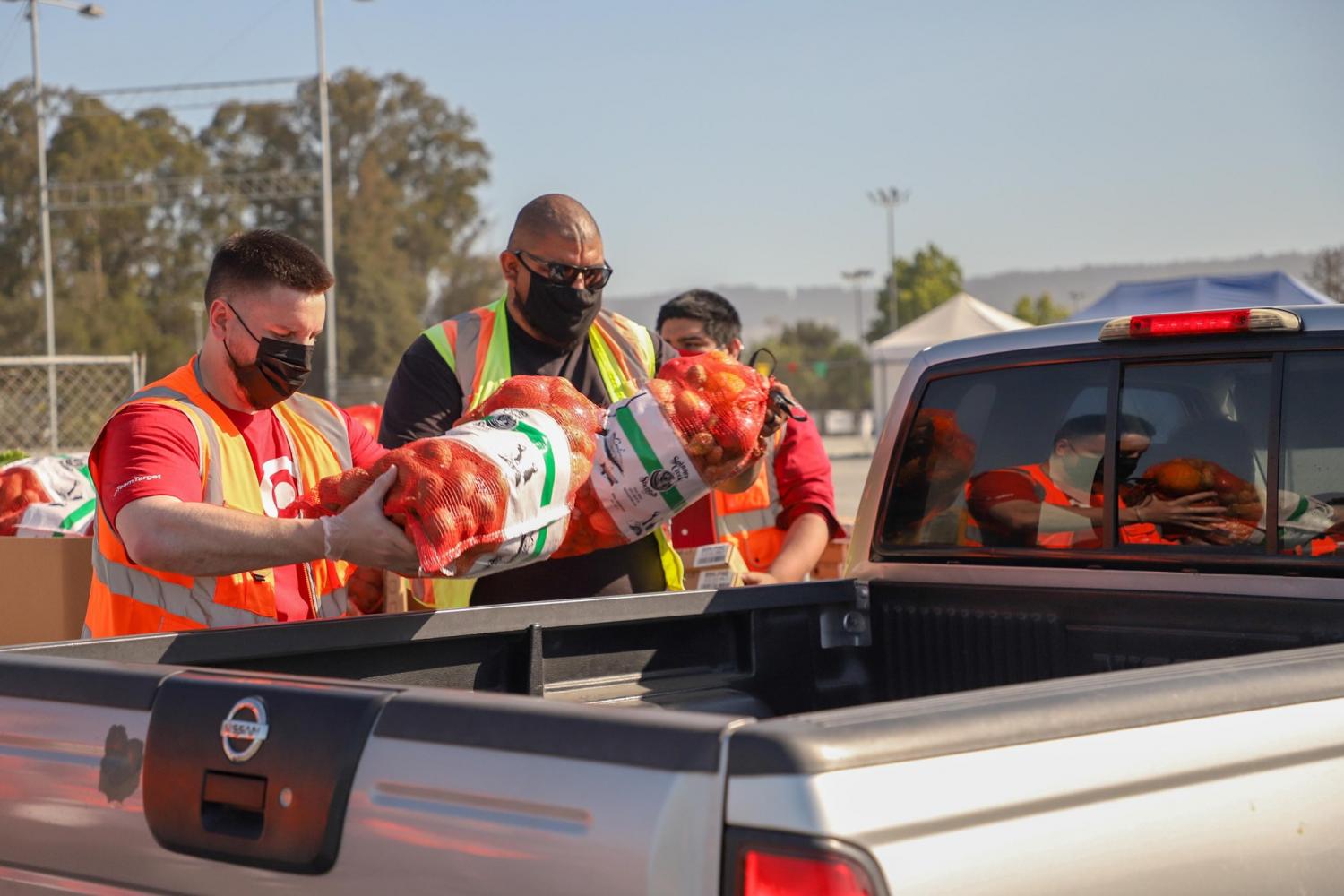
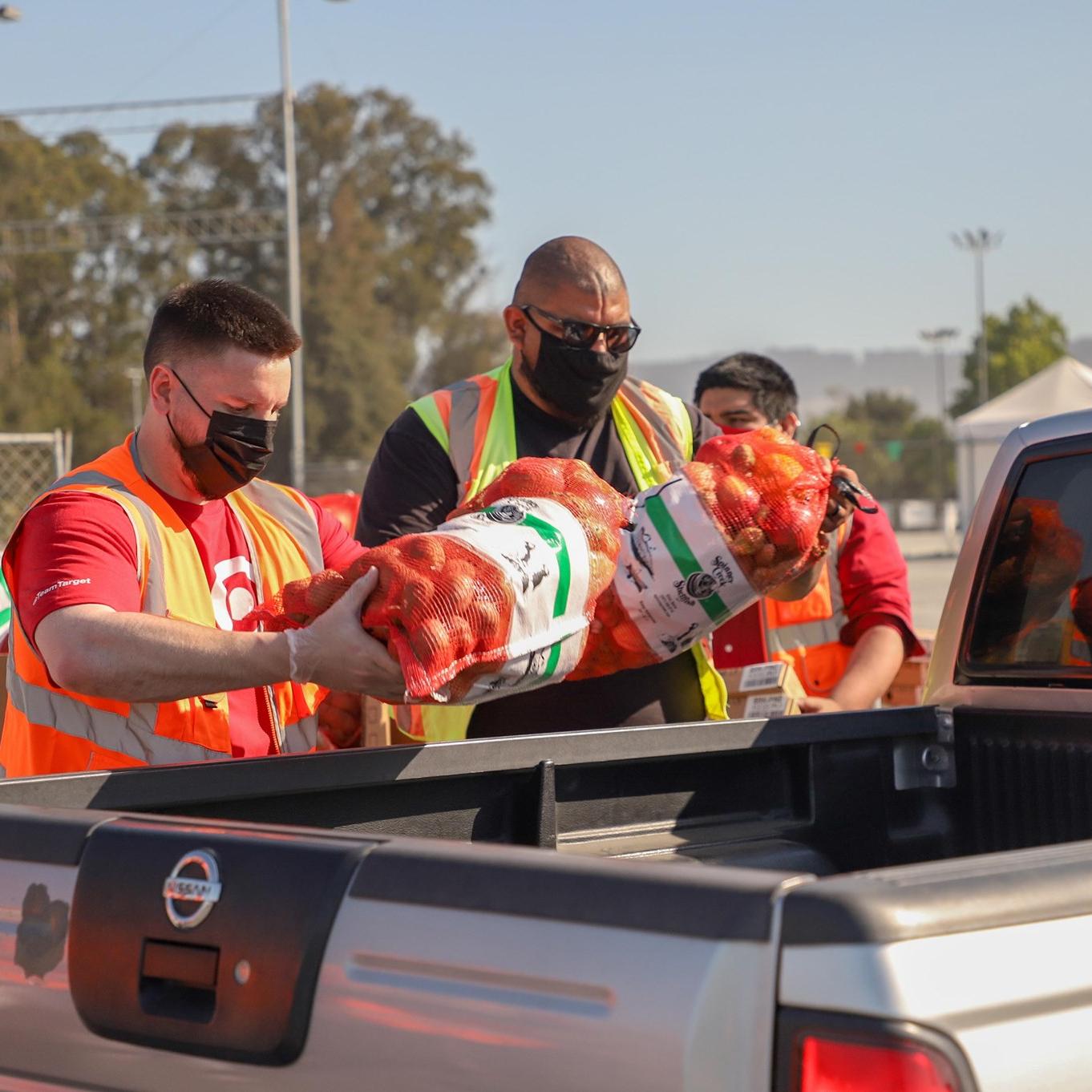
Among the many images seared into our collective memory during this pandemic are the photos of long queues of cars waiting to get bags or boxes of groceries from food banks. Here in California’s central coast, those of us at Second Harvest Food Bank Santa Cruz County continue to see high demand for food, and there are a lot of unknowns about what a new normal may be as the Delta variant continues to take its toll. The challenges we face in this county home to 275,000 is similar to what communities confront nationwide, from the Bay Area in Northern California to wealthy Fairfax County, just outside of D.C. in Virginia. Even as the federal government’s Supplemental Nutrition Assistance Program (SNAP) is poised to increase its benefits significantly, some won’t qualify – and many families who are eligible won’t necessarily apply for benefits due to the stigma associated with needing food assistance
Numbers tell the story behind the dire need for food banks
Second Harvest Food Bank of Santa Cruz County has been consistently distributing slightly more than 1 million pounds of food monthly for the last year, according to Suzanne Willis, chief development officer at Second Harvest Food Bank.
”Prior to the pandemic it was about 650,000 pounds monthly. At the height of the pandemic, April/May/June 2020, it was up to 1.2 million pounds. The need among food-insecure people has slackened only modestly but remains consistent. We’re anticipating this higher level of demand for the next 18 – 36 months,” Willis said.
The real concerns among food banks nationally is the news about employers desperately needing to hire. As COVID-19 restrictions are reduced, people who normally contribute to their local food banks, as well as larger donors, who are inspired to give during disasters, may at first feel less of a need to contribute any support. Nevertheless, it’s clear the demand for food assistance remains and sustaining support is still critical.
Economic headlines tell more
California’s full re-opening this past June masked continuing problems. While some people have been moderately or untouched by pandemic’s economic impacts, food banks are clearly facing continuing support needs by a larger number of people who are still harder-hit than before last year’s COVID-19 shutdown. Continuing that high level of financial support is essential for effective food bank operations and crucial for supporting the large numbers of local food-insecure families.
Key factors include retail price increases across many sectors, especially food and accumulated back rent and mortgages.
As CNN Business reported on June 4, “Global food prices surged to their highest level in a decade.” Global food prices rose for the 12th month in a row in May, up nearly 40% year over year, according to the United Nations’ food price index. Average prices are at their highest point in nearly a decade.
A LA Times article from earlier this year points at an additional problem: How long it will take citizens who owe back rent to recover? Evictions and debt could spike if the recently extended federal moratorium ends. This is true nationwide, as many U.S. states have stopped extended unemployment benefits just as the Delta variant has sparked another dangerous wave of the virus.
Santa Cruz County’s employment statistics only tell a part of the story –in many areas across the U.S. the cost of housing keeps in increasing. There is a large portion of our local population who are under-employed, meaning they work part- or even full-time but earn less, often far less than what’s necessary in our high-cost-of-living area. The poverty line by federal government standards, is about $24,300 for a family of four, according to 2018 statistics. That’s more than 15 percent of our county’s population that fits the federal definition for poverty. However, when considering the cost of living and the availability of social services, more than 23 percent of our county’s residents fall below a more realistic poverty line of $33,953 for a family of four.
Seasonal workers in agriculture - the people picking, packing and processing the healthy food we all eat - often fit into this category. So do many college students, retail workers and those working in the hospitality sector. Baristas at the coffee shop, bank tellers, restaurant waiters and hotel staff are likely earning well below the poverty line.
With all the affluence visible in Santa Cruz County, the population of people facing food insecurity unfortunately isn’t shrinking. Food banks are one of the safety nets we can’t allow to fall apart. In many cases, after people pay rent or their mortgage in this county, they don’t have money left for food. Accessing food at no cost lets people avoid evictions and foreclosures, plus they remain healthier.
As your company, large or small, considers how to give back to your local community, consider a generous donation to your local food bank. While a live or virtual “canned food drive” may have good intentions, the reality is your local food bank will know how to meet the needs of local citizens. “Financial donations are more flexible. The needs of people in crisis can change weekly, daily or even hourly, and cash donations allow nonprofits to respond to those needs more rapidly,” wrote Katherine Wiles for Marketplace.
Cash donations also go much further as food banks across the nation can turn one dollar into four meals due to partnerships with food manufacturers or farmers to purchase food at cost or wholesale.
Image credit: Second Harvest Food Bank/Facebook
Your Quick Guide to Supporting Black-Owned Businesses
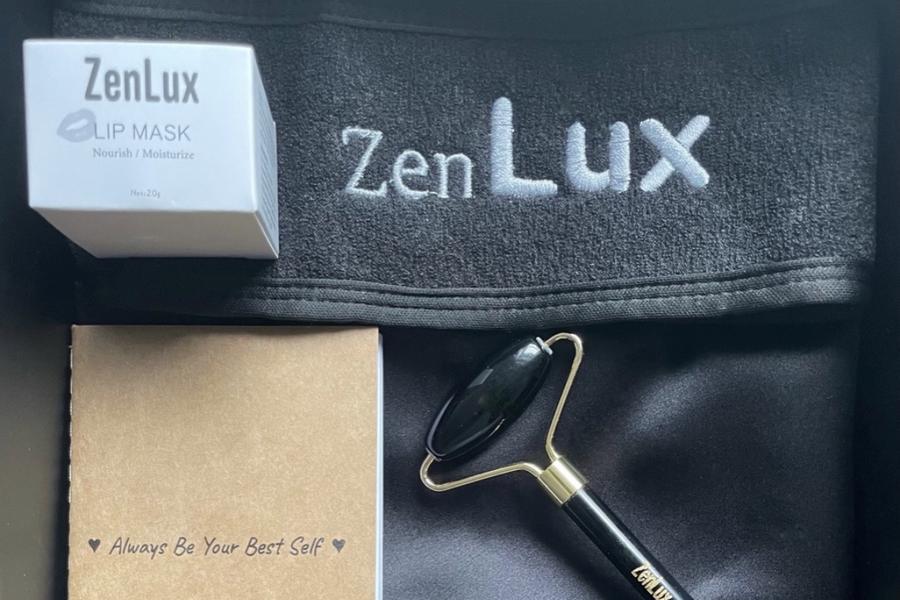

ZenLuxCo’s overall mission is to help promote the empowerment of women and provide practical solutions to ultimately allow women and girls be their very best selves and present their best foot forward. “We are big on self-care and pampering for women and girls of all ages and walks of life, and sell a variety of products,” said Ashley Blain, the company’s founder. “Our kits are specially and carefully curated for individuals who cherish all things beauty, skincare and self-care. The need we fill is providing products that makes self-care routines and skincare routines easier.”
In a recent interview with TriplePundit, Blain was confident, even ebullient, about her company’s prospects. As an owner of a Black-owned business, however, she made it clear that her company does face its share of challenge.
“It’s hard to find Black-owned businesses because a small number of us are entrepreneurs, and within that small number it can be hard to distinguish which businesses are Black-owned,” Blain added. “I am so glad there are apps and websites dedicated to highlighting Black-owned businesses, thus making it easier to find them.”
More companies are realizing the benefits of reaching out and having a more inclusive approach when it comes to assisting Black-owned businesses. United Airlines, for example, recently launched an app that lists such companies and services in the Houston area, one of the carrier’s largest hubs.
For consumers keen on supporting Black-owned businesses, here’s the mantra: research, show up (virtually or in-person), write reviews, share on social, spend and repeat.
“Consumers can support black owned businesses by simply buying from them. It also helps to leave reviews on websites and social platforms as it provides credibility to other consumers and potential customers,” explained Blaine. “Telling family and friends about the product or service you have received from a Black-owned business helps to further promote them. When everyone as a whole chooses to use their buying power to support Black-owned businesses, it helps to uplift us all.”
As for owners of Black-owned businesses seeking to gain new customers, Blain suggested going local. It’s no secret Black entrepreneurs and business owners have had their struggles tapping into federal funds over the past 18 months; and while there are nonprofits that can help with the red tape, access to resources is still an ongoing problem.
“One of the resources I turned to is the NYC Department of Small Business Services. I started my business during the pandemic, and the resources they have provided still help me to this day,” Blain said.
Blain’s company launched June 1; so far her best seller has been a line of “Me Time” kits.
Image credit: ZenLuxCo
How Business Leaders’ Commitments to Black America Have Fallen Short
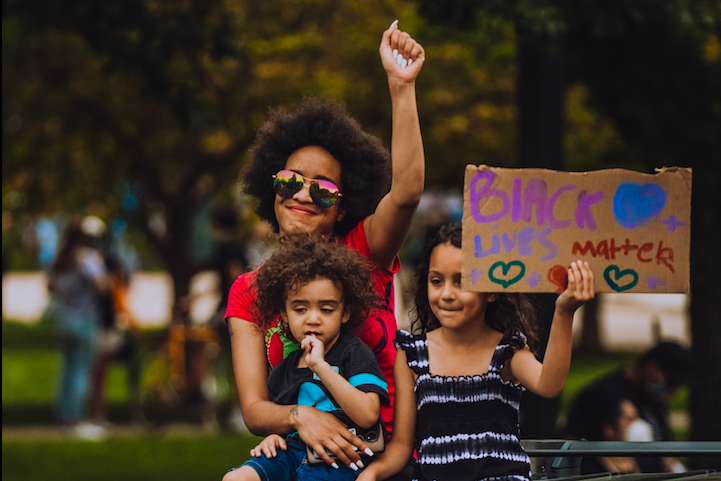

A Washington Post analysis of the financial promises that 50 of America’s largest companies made to Black America last summer shows that those once-bold pledges have so far led to questionable impact.
First, the amount of dollars that companies have actually spent versus what they had promised turned out to be a pittance, according to the Post’s number-crunching. To date, only 3.5 percent of the almost $50 billion in financial commitments could be verified.
This research has found that while CEO after CEO proclaimed last summer that they stood with Black Americans, only a sliver of those funds was given to organizations that are dedicated to pursuing criminal justice reform, which is what last summer’s Black Lives Matter rallies and protests across the U.S. were largely about in the first place.
The Post’s reporters also found that 90 percent of those large corporate pledges – more than $45 billion – were loans or other investments from which such companies would profit.
This is not "necessarily a bad thing," observes Ellen McGirt, senior editor of Fortune and lead author of the publication's lauded RaceAhead newsletter. "But it’s a thing worth understanding."
Programs designed to boost homeownership for Black families, which would help generate financial returns for any company, aren’t a bad idea at face value. But one such home buyer grant program in the Minneapolis area would allow anyone to buy a home in a majority Black or Latino neighborhood no matter what their race may be, which would allow white families who hold more wealth to benefit and in the end risk even more gentrification and displacement of Black families.
Editor's note: Be sure to subscribe to our Brands Taking Stands newsletter, which comes out every Wednesday.
Less than 10 percent of this multibillion-dollar promise for Black America went toward grants for community groups. “The $4.2 billion in grants, to be disbursed over as long as a decade in some cases, represents less than 1 percent of the $525.6 billion in net income earned by the 50 companies in the most recent year,” the Post concluded.
The one beneficiary of corporations’ largess? Historically Black colleges and universities (HBCUs) have reaped $345 million in donations, though the Post’s review said the end result could be a wider gap between smaller schools and the more elite HBCUs.
At a higher level, while companies may have appeared to be bold and courageous last summer, in the end they, their CEOs and their boards of directors are still risk averse. Donations for causes such as health, equity and education are seen as safe and much less triggering than any reforms targeting policing and the criminal justice system.
“Education is a fairly noncontroversial, conservative impulse in terms of corporate donations,” Robert E. Weems Jr., a professor of business history at Wichita State University, explained to the Post, adding, “when in fact George Floyd as a catalyst specifically had to do with criminal justice and policing.”
Image credit: Jakob Rosen/Unsplash
Chocolate Company Beyond Good Lives Up to Its Name

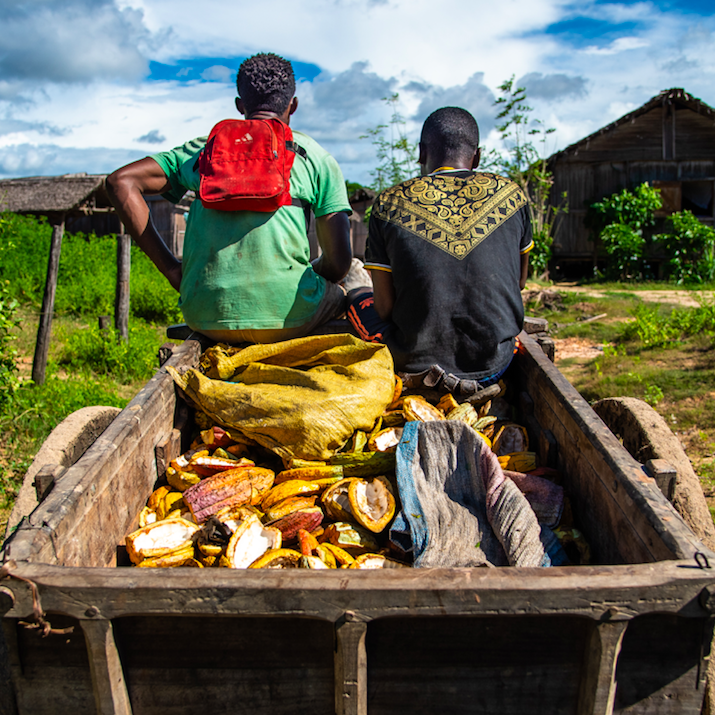
If Madagascar-based Beyond Good’s founder Tim McCollum’s life were one of those “based on a true story” films, the director had better open the first scene like this (assuming these types of films take creative liberties):
“A driver whips quickly yet slyly around a bend at the port, looking to surprise the team he’s been working with for the past several years. He spots them, pulls close to the curb and unwinds his hand-crank window while giving a toothy smile to the unsuspecting group he’s picking up. Tim, the group leader, inches closer, not believing his eyes. He dramatically takes off his sunglasses to confirm what he sees. It’s true. One of his smallholder farmers has his very own truck. And they’re about to go for a ride.”
It hasn’t all been toothy smiles and pickup trucks — the journey to building a sustainable, transparent, profitable chocolate company in one of the poorest countries in the world has been as bumpy as the 435-mile (700-kilometer) road that connects the smallholder cocoa farms to the factory based in Madagascar’s capital, Antananarivo.

Beyond Good started in 2008 with a simple mission: Manufacture chocolate at the origin. Traditionally, the life of a cocoa pod farmed in Madagascar is exhausting, moving from farmer to middleman to another middleman (and maybe even another middleman or two) to an exporter to a foreign factory. This cycle is especially true in cocoa-rich West African countries like Ghana and Cote d’Ivoire, where cocoa is commoditized en masse, tainting its identity and richness in the process.
McCollum’s company sought to disrupt this supply chain. Cutting out the upwards of five middlemen and establishing an in-country chocolate making factory, he thought, was the recipe for success (pun intended). Not only would it improve the quality and transparency of chocolate since the cocoa could be easily traced back to a specific grower, but it crucially put more money into the pockets of the farmers. No middlemen meant no shaving money off at each stage of the supply chain.
And withstanding growing pains from Madagascar’s poor infrastructure and well-placed hesitation from farmers, Beyond Good’s model worked. By the company’s calculation, its farmers earn $3.84 a day, five to six times that of their West African counterparts, and nearly triple Madagascar’s GDP per capita.
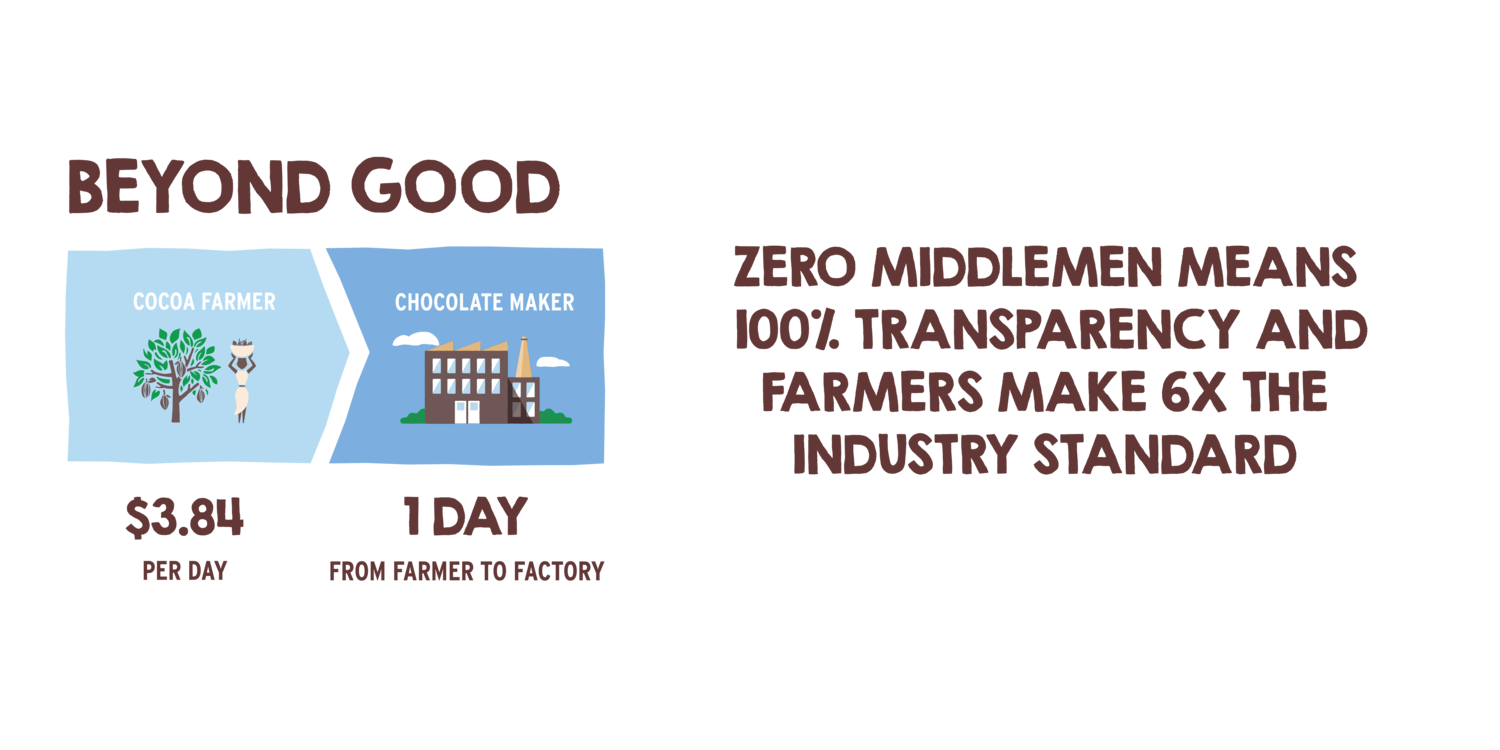
“It took five years to get to a point where we would walk into a village and a farmer would trust us,” McCollum told TriplePundit, also noting his Peace Corps experience in Madagascar contributed to breaking down those walls. “The turning point was when it started to work. Farmers could tie their increase in standard of living to what they had done themselves, which was farm better cocoa and get paid more money for it. That’s when it takes off like wildfire in a community.”
Word of mouth travels quickly in a small village, especially when your neighbor buys a truck from the profits he’s made as a farmer. Beyond Good now has 93 farmers, though that number is climbing and expected to reach 120 by the end of March of next year. That’s in addition to the 50 chocolate makers it employs in its factory in Madagascar’s capital Antananarivo. In 2021, McCollum expects the company to churn out between 3 million to 4 million chocolate bars — three-quarters of which are made at its Madagascar-based factory while the others are produced at a factory in Italy to diversify risk and meet growing production numbers. Sales, meanwhile, are driven almost exclusively through the United States, at markets like Whole Foods, Sprouts, and online on Beyond Good’s website and Amazon.
The goodness of Beyond Good lies also in its less-intended consequences. Deforestation due to cocoa production is a major black mark on the chocolate industry, especially in West Africa where two-thirds of the world’s cocoa originates. For example, Mars Inc., one of the world’s most recognizable chocolate makers, fell short on a 2009 pledge to entirely end deforestation from its business within 10 years. In the last 50 years, Cote d’Ivoire has lost an estimated 80 percent of its forest, some of which can be traced to farmers cutting down large swathes of protected forests to expand their plots.
“Anytime someone bites on a chocolate bar in the United States, a tree is being cut down,” Eric Agnero, an environmental activist from Ivory Coast, told the Washington Post in 2019.
Beyond Good farmers have taken the opposite approach: agroforestry and reforestation. Instead of chopping down forests to pave the way for additional plot land, the farmers have been converting rice lands into new shaded areas where cocoa pods sprout alongside banana, jackfruit and citrus trees. The result is a beautiful canopy, a sustainable crop and a home for a lemur population that has borne the brunt of Madagascar’s disappearing forests. Beyond Good commissioned the England-based Bristol Zoological Society to study lemur conservation in and around the canopies where their farmers harvest cocoa. Six months of studying night cameras, camping under the shade trees, and recording intensive interviews with the farmers confirmed five or six lemur species living among the canopy.
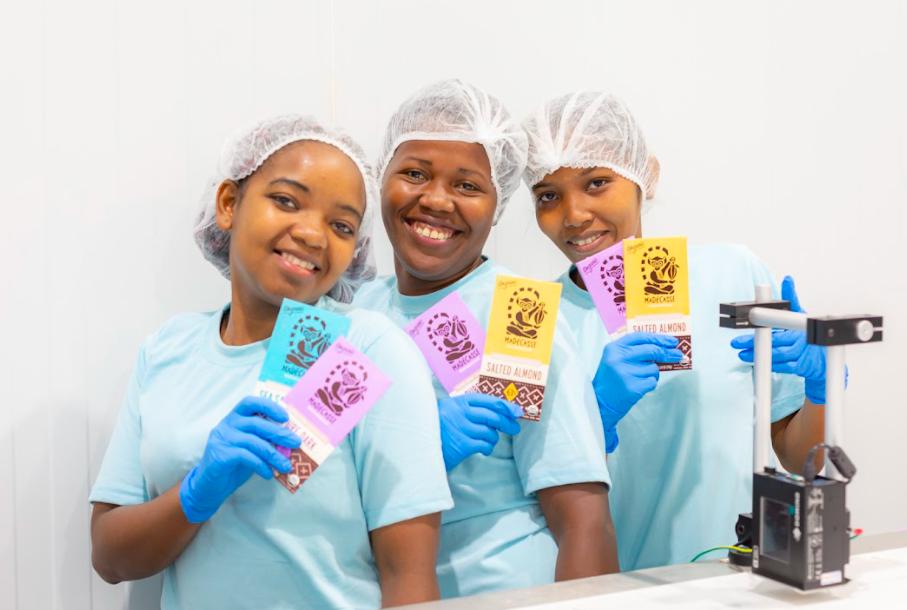
“We never asked a single farmer to plant a tree,” McCollum said. “The incentives with our partnership were so good that they did it on their own. We were excited to start doing this in a corner of the country where it was baked into our business, which is much more sustainable than a one-off project. It’s happening naturally because people are incentivized to do it on their own.”
Child labor has also marred the chocolate industry. Despite two decades of promising to eradicate child labor from its supply chain, critics of chocolate giants such as Hershey, Nestlé and Mars say the companies continue to turn a blind eye from who is doing the heavy lifting. Lack of transparency drives this problem. As the Washington Post’s Peter Whoriskey and Rachel Siegel exposed child labor in the cocoa industry of West Africa, they also concluded that Mars could trace only 24 percent of its cocoa back to farms. Hershey and Nestlé were also unable to trace the majority of their cocoa to its source. Even if the companies’ intentions to end child labor are genuine, the lack of visibility into where their supply is coming from makes it impossible to guarantee that children are kept on the sidelines and prevented from working on these farms
Beyond Good, on the other hand, has full transparency into where its cocoa is coming from. As a result, the company says that to date it has not experienced any instances of child labor.
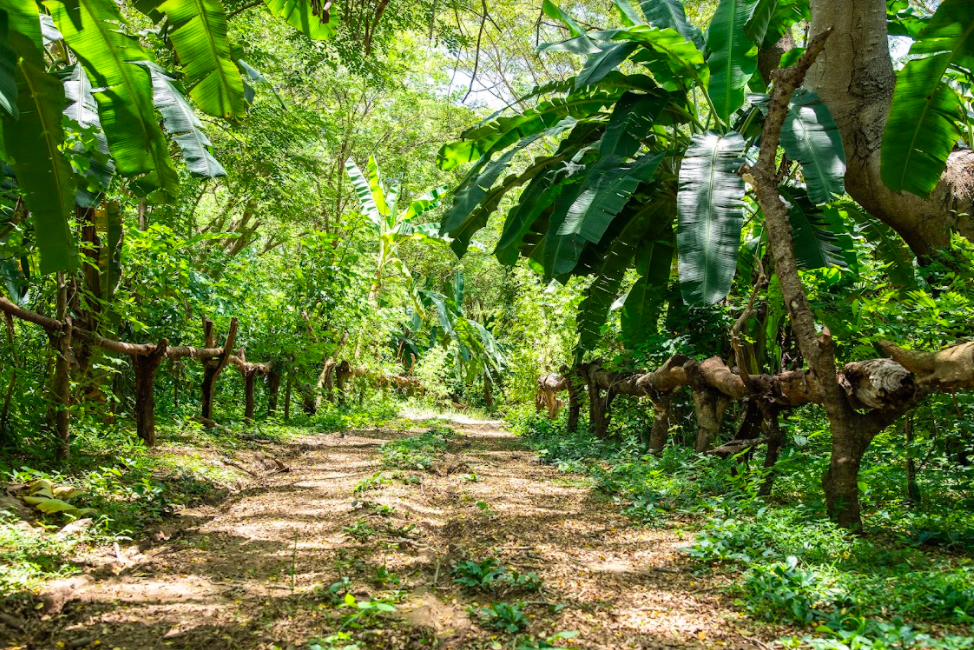
McCollum is convinced that this business model isn’t limited to the confines of the east African island country. His confidence will be put to the test soon as Beyond Good expands its operations to Uganda, with its eyes set on opening a factory (or two or three) in 2022.
Business model aside, McCollum also credits Beyond Good’s success to the genetics of the cocoa in Madagascar, which he says “tastes different and has more flavor” than cocoa found anywhere else in the world.
“It’s important from a sustainability point of view because since it’s a higher quality cocoa, we can pay farmers a lot more for it,” McCollum said. “The road through sustainability as it relates to farmer poverty goes through better quality cocoa.”
Image credits: Beyond Good
Floating Offshore Wind Power: America’s Secret Weapon in the Global Decarbonization Race

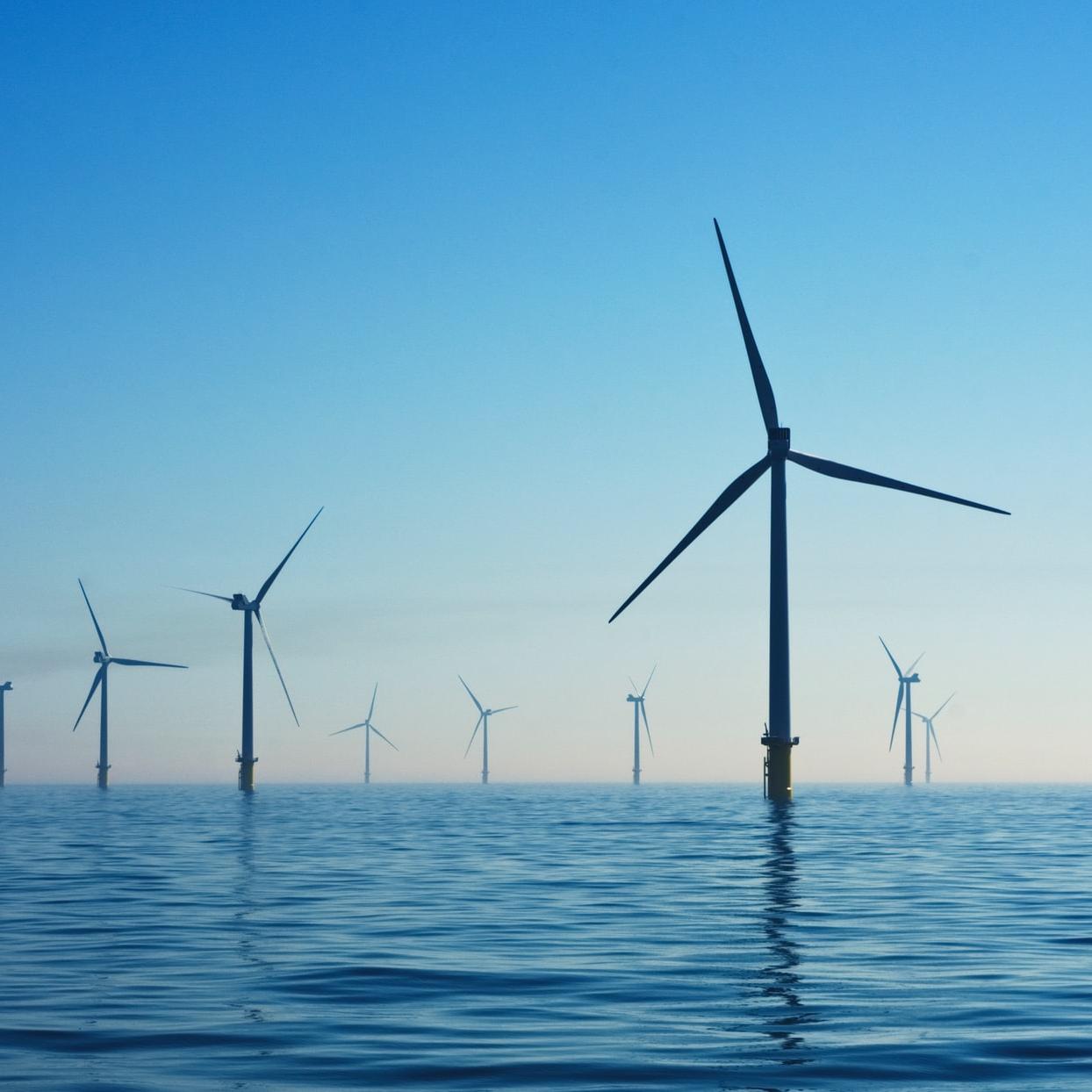
The latest IPCC report on climate change paints a frightening picture, but it also indicates there is time for rapid decarbonization to make a difference. For the U.S., that means tapping into massive new energy resources that have been dormant all these years. Floating offshore wind power is one of those areas, and it finally appears to be rousing from its slumber.
U.S. offshore wind power has barely budged in years
At first glance, any kind of offshore wind power in the U.S. would appear to be a non-starter. Even though conditions for offshore wind development are ideal along most of the Atlantic coast, the U.S. has lagged far behind the U.K., the Netherlands and other nations.
The offshore wind market began accelerating elsewhere around the globe during the Barack Obama administration. Unfortunately, federal efforts to coordinate Atlantic coast wind developmen in the U.S. were stymied by legislators and governors in several Atlantic coast states, reportedly linked to the influence of the Koch family. A Koch family member was also instrumental in delaying the proposed Cape Wind project in Massachusetts, which would have been the nation’s first offshore wind farm.
Cape Wind was eventually abandoned and so was another early project, Fisherman’s Energy in New Jersey. The only one to survive the early years was the Block Island Wind Farm in Rhode Island.
Block Island is still the nation’s only commercial offshore wind farm in operation. With five turbines and 30 megawatts of capacity, it pales in comparison to other projects around the world, like the 174-turbine, 1.2-gigawatt Hornsea wind farm in the North Sea. The first 50 Hornsea turbines went into operation in 2019.
Another North Sea project, the three-phase Dogger Bank wind farm, will have a capacity of 3.6 gigawatts when fully built out.
A secret weapon in the offshore wind power race
The U.S. appears to have been sleepwalking through all this activity, but appearances can be deceptive.
One key step occurred during the George W. Bush administration when Congress passed the Energy Policy Act of 2005. The new law established the Outer Continental Shelf Renewable Energy Program, which laid the groundwork for coordinating the lease of federal offshore areas. The Interior Department’s Bureau of Ocean Energy Management (BOEM) finalized the leasing process in 2009.
Republican office holders tied the Obama administration’s hands for the eight years following 2009, but oddly enough, the Donald Trump administration helped to free the logjam. Despite that former president’s well-known distaste for wind turbines, BOEM continued to lease out federal wind areas at a rapid pace all through his first and only term in office.
By the time President Joe Biden was inaugurated, the stage was set for a surge of activity along the Atlantic coast.
NBC-TV recently ran the numbers and counted 17 different offshore wind farms in the Atlantic coast pipeline, totaling 1,500 wind turbines.
All of these wind farms have a secret weapon up their sleeves. Today’s wind turbines are more powerful and efficient than the technology of just a few years ago, helping to drive down the cost of offshore wind power. Streamlined construction methods and a maturing supply chain also put today’s offshore wind projects a cost advantage over those built in earlier years.
The International Renewable Energy Agency (IRENA) notes that offshore wind is still relatively expensive compared to onshore projects, but costs have been declining rapidly since 2014 and further significant declines are anticipated.
Floating offshore wind, the other secret weapon
So far, U.S. offshore wind activity has clustered only along the Atlantic coast, where relatively shallow water enables the construction of conventional, fixed-platform wind turbines.
For deeper and more challenging waters, floating wind turbine platforms are needed. Floating wind technology is relatively new, but it is already emerging in the commercial market and investors are already targeting the U.S.
As with Atlantic offshore wind development, overseas investors are driving the U.S. floating wind turbine market. That is the unfortunate payoff for years of obstruction and uncertainty fostered primarily by Republican office holders. It is also somewhat ironic, considering that the U.S. Department of Energy has been an early supporter of efforts to improve floating wind turbine technology.
Still, overseas investors can stimulate significant local economic activity in the U.S. The National Renewable Energy Laboratory ran the numbers in June, and calculated $12 billion annually in U.S. capital investment will occur in future years as the result of offshore wind development.
Ireland’s Simply Blue Group is among those targeting the U.S. for investment. Altogether, the firm already has a pipeline of 9 gigawatts in floating offshore turbine projects under its belt. Now it is eyeing the U.S. floating offshore wind market, which it calculates at 30 gigawatts.
Much of the opportunity lies along the Pacific coast, with other areas including parts of the Atlantic Coast and the Great Lakes.
Simply Blue notes that 80 percent of the U.S. population lives in coastal communities. Land for both solar and wind farms is limited in these areas, making offshore wind development all the more imperative. Offshore wind resources can also help alleviate the need for major new transmission lines onshore. Floating wind turbines offer the additional advantage of remote sites that reduce or eliminate visual clutter from the shoreline.
Although floating offshore wind technology is currently more expensive than fixed-platform technology, costs are already coming down and further declines are anticipated.
As for the climate crisis, the U.S. Department of Energy estimates that an overall total of 2,000 gigawatts in offshore wind power capacity are within reach in domestic waters by today’s technology. That is approximately twice the nation’s current electricity usage, meaning there is ample room for electrifying vehicles, buildings, and factories.
The means of decarbonizing the U.S. economy are already at hand. The only missing element is the political will to make the transition from fossil fuels to clean power as quickly as possible.
Up to now most of all the heavy lifting on climate action has been done by Democrats in office. A shift in the political winds is long overdue, but with the economic consequences of inaction already looming into view, the time is now for swift, unified action by all legislators in Congress and in statehouses across the country.
Image credit: Nicholas Doherty/Unsplash
Progressive Finance’s Role in Generating Renewables for All


Money is the lifeblood of the economy. Where money flows, economic muscle grows. Money, like energy, is essential to human survival on this planet. No nation knows this as well as the United States, especially considering 2020’s $21 trillion in gross domestic product.
Moreover, concluded in the latest IPCC report on climate change, the survival of the human race is in dire jeopardy, especially as the world continues to run the biggest atmospheric “doping” scandal of all time. In the midst of this pickle, the report provides a glimmer of hope: “The science is clear that if emissions are slashed then temperatures will stop rising in a decade or two and the increases in deadly extreme events will be strongly limited,” writes the report’s authors.
The United States, with about 4 percent of the world’s population, has consistently consumed 25 percent of the world’s energy. As of 2020, merely 12 percent of total U.S. energy consumption stemmed from renewable energy sources; that explains the annual whopping 6.6 million metric tons of carbon dioxide equivalent (CO2e) emissions.
Clearly, more than ever, it is the imperative of the U.S. to rapidly deploy renewables in the race to a zero-emission economy. Can U.S. investors and consumers flex their money muscles to help save the world?
A quick intro to progressive finance
Progressive finance, as defined by Keith Mestrich and Mark Pinsky, relies on a balance of public and private gains based on public and private risk sharing. This contrasts conservative finance as it aims to leverage private gains off public risk sharing. Progressive finance is a path that can result in a positive impact on investors; consumers alike could follow to ensure an equitable and inclusive transition to renewables. As the authors’ write, “The ways we choose to organize money tells others about us. And we learn about ourselves.”
Investors and consumers have the potential to make the renewable transition a just one, but there will be a long road ahead.
Closing the financial and renewables doors on communities of color
Over the past decade large U.S. banks have fled from rural as well as low- and moderate-income (LMI) communities. Local residents are left to deal with this blow as these closings mean sharp declines in local business lending.
The act of closing the doors on rural and LMI communities is a trend that is also reflected within the growing U.S. solar market. When renewable power investments are left in the hands of a few large institutional investors, solar “redlining” begins to occur. Solar redlining occurs when community-based projects are overlooked for utility-scale projects. This trend excludes the majority of U.S. communities, especially communities of color. A renewable power system of “haves” and “have nots” is boiling to a head, further dividing the nation with racial and economic lines.
An equitable approach to the energy transition
Provided federal tax incentives, well-paid organizations and individuals benefit tremendously from investing in solar projects. Coupling a dollar for dollar tax credit and accelerated depreciation deductions, taxpayers are capable of investing in a revenue generating (solar) asset with nearly 50 percent of their investment earned back in year one. This is such a sweet deal that only few banks, corporations and individuals can take advantage of. However, these incentives are leading to exclusive projects often found in, predictably, exclusive neighborhoods. How can the majority of individuals contribute and benefit to an energy grid powered by renewables? For starters, investors and consumers can look towards community solar.
Spreading the financial and environmental benefits: community solar
Over the past few years across the U.S., community solar has started to thrive. These projects energize the homes of many, from renters to small business owners to farmers. Customers who participate in these programs earn credits on their utility bills, all the while supporting the production of renewables. Community solar is an innovative practice that brings energy savings and paves the way for a just energy transition while including those who may not have the capabilities to install solar panels on their respective rooftops. For LMI residents, even the slightest of energy savings go a long way. The reality is, many residents are unaware of the savings and whether or not they qualify. Click here to find out.
Through community solar, corporations, community banks and high-net worth individuals can help invest in underserved neighborhoods. Starbucks, for example, announced the completion of a multi-year community solar plan in New York State, generating up to 90 megawatts of capacity. Starbucks announced, “The projects are expected to supply solar energy for local Starbucks stores and up to 24,000 households, small businesses, nonprofits, churches, universities and stores in multiple geographies.
Leveraging the financial tools, regulations, and wallets can help grow a resilient and equitable energy market across the entire country. Wealthy or not, there are ways to contribute. Community development financial institutions (CDFI’s) harness individuals’ savings and help to revive economic life into underserved communities. City First Broadway, a black owned CDFI that serves five states, does just that.
As already mentioned, high-income earners, corporations and banks of all kinds can take advantage of federal incentives while receiving steady flows of cash over-time. Now, with new innovative business models, all communities can benefit in the process. Sunwealth, a clean-energy investment firm, is one example for a company that provides the opportunity to profit off of clean energy projects while generating meaningful returns for communities. Partnerships between the government, investors, businesses, and community members can result in projects like the 1.8 megawatts of rooftop solar installed in Queens, New York.
Inclusive investments are needed to help tackle climate change
Avoiding an exclusive energy transition that only benefits the few is one that behooves citizens to take action for a myriad of reasons. Think of this effect similar to a gym-rat who only hammers bicep curls; the muscles becomes lopsided. When investments in renewables flow to only a few parts of the economy, it is easy to see the effects of a poorly planned transition, especially one that overlooks he ordinary working class families. No matter the size of our wallet, we can all act accordingly as we prioritize our investments, savings and spending. If we do this with a long-term impact for everyone in mind; we’ll all be stronger in the end.
Image credit: Pixabay
Diversity Matters, As Nasdaq Tells Companies


As of early August, companies listing on Nasdaq are now subject to a new rule that requires public disclosure of the diversity within their boards. In addition, such companies need to have, or explain, why they do not include at least two “diverse” members. Nasdaq defines this as at least one female director and one that is an underrepresented minority or LGBTQ+. In addition, smaller companies, foreign issuers and companies with five or fewer directors have greater flexibility in meeting the diversity objectives and can have two women instead.
The SEC approved the new rule on August 6, and to be clear, Nasdaq’s rule does not actually mandate having a diverse board. Instead, it merely requires companies to disclose diversity indicators annually or else provide an explanation. By contrast, California’s legislature passed a law in 2018 (SB 826) requiring boards of publicly traded companies to have at least one female member or face a fee of $100,000.
Proponents of the new rule believe it will force boards to become more diverse and inclusive. The idea is that transparency bolsters accountability. Currently, more than 3,300 companies are listed on Nasdaq, and 12 percent don’t have any women on their boards. Likewise, more than a third lack a director who is a person of color. This reality persists despite the amount of research that makes an economic case that companies with diverse boards often perform better – and that was especially true during the pandemic.
“The data shows clear evidence that there’s a small-cap company gap when it comes to diversity on U.S. boards,” Marija Kramer, head of ISS Corporate Solutions, said in an interview. “Listed companies, if they aren’t already, should think about how they’re going to recruit for more diverse directors.”
The lack of diversity is not limited to the Nasdaq alone. For example, of the Russell 3000 corporate board members, only 4.1 percent were Black directors and 21 percent were women in 2019. Yet, 13.4 percent of the U.S. population is Black. Likewise, Latino and Asian Americans were not proportionately represented on boards.
Increasingly, pressure has been mounting to eliminate systemic racism and promote corporate diversity. In June 2020, Reddit’s co-founder and executive chairman of the board, Alexis Ohanian, stepped down and said, “I’ve resigned as a member of the Reddit board, [and] I have urged them to fill my seat with a Black candidate.” His seat was, in fact, filled by Michael Seibel, an African American entrepreneur.
According to a study in Harvard Business Review, a few hurdles need to be overcome to lower barriers to and within the boardroom. Often the pipeline of candidates to boards tends to be white male executives. Director recruitment on all-white boards tends to consider fewer candidates that are racial and ethnic minorities. Also, when considering how Black board members were initially introduced to the board when they were already known, it is more likely to be by a Black director (54 percent) than a white director (35 percent).
If the same concepts apply to other racial minorities, it means that boards that the lack of diversity is likely to stay that way unless something causes them to change course. The good news is that once some diversity is achieved, it is more likely to continue.
The study also found that Black directors were less likely to serve board leadership roles as a chairperson or committee chair than white members, despite having higher levels of education on average. This raises the concern that the contribution of some members can be ignored or undervalued. Thus, it is critical to have minority members serving on boards and that the boards are open to their contributions.
The big question about the new rule for Nasdaq-listed companies is if transparency alone will lead to positive change. The California law mandating that at least one woman serves on the board is both a mandate and comes with a $100,000 fine. The good news is that more women are now serving on the boards of publicly traded companies in California.
Will merely requiring transparency generate the same results? It certainly will serve as an incentive for many companies to attract more high-quality minority and female candidates. Although this step might not solve the issue for Nasdaq-listed companies that lack director diversity, it’s a definite step in the right direction towards a more inclusive business community.
Image credit: Pixabay